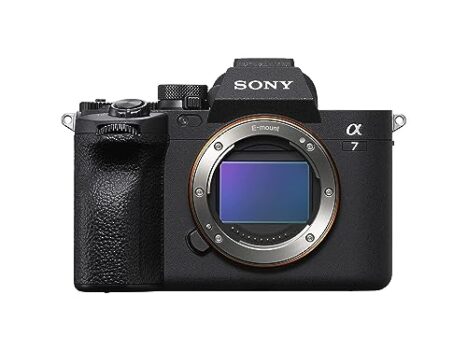The Definitive Technical Compendium: The Sony Alpha 7 IV Full-frame Mirrorless Camera
Introduction: Redefining the “Basic” and the Dawn of the True Hybrid Era
For the past decade, the digital imaging landscape has been on a relentless evolutionary march, driven by a singular, powerful demand: the need for a true “hybrid” camera. The modern creator is no longer just a photographer or just a videographer; they are a visual storyteller, often required to be both simultaneously. The days of carrying a specialized stills body and a separate, cumbersome video camera are rapidly fading. The new imperative is for a single, versatile instrument that can capture a breathtaking, high-resolution photograph one moment and then, with the flip of a switch, record cinematic, professional-grade video the next, with no significant compromise to either discipline. For years, the Sony Alpha 7 III was the undisputed champion of this movement, a camera that so perfectly balanced performance and price that it became the benchmark against which all others were measured.
Today, that benchmark is shattered. The Sony Alpha 7 IV arrives not as an incremental update, but as a fundamental redefinition of what a “basic” full-frame camera can and should be. It takes the beloved formula of its predecessor and elevates it to a new stratosphere of capability, effectively democratizing the core technologies of Sony’s flagship Alpha 1 and professional cinema lines. The philosophy of the a7 IV is built on a trinity of powerful advancements: a brand-new, high-resolution 33-megapixel sensor that offers incredible detail and flexibility; the next-generation BIONZ XR processing engine, a flagship-level brain that unlocks unprecedented speed and performance; and a completely overhauled, professional-grade video feature set, headlined by 10-bit 4:2:2 color depth and the coveted S-Cinetone color profile.
It is crucial to understand that the a7 IV is a tool engineered for the serious creator. It is for the professional wedding photographer who needs to deliver stunning, large-format prints and a cinematic highlight film from the same event, using the same camera. It is for the dedicated YouTuber and online content creator who has graduated beyond basic vlogging and now demands the image quality and color flexibility to produce truly polished, broadcast-ready content. It is for the advanced hobbyist who is passionate about both the art of photography and the craft of filmmaking and refuses to compromise on either. It is for the working professional who needs a reliable, do-it-all workhorse B-camera that can seamlessly match the output of their primary cinema or high-end stills camera. The a7 IV is the new standard for this versatile, demanding, and dynamic class of user.
This document is conceived as the most exhaustive technical guide to the Sony Alpha 7 IV available. Our mission is to move far beyond a superficial overview of its features. We will embark on a deep dive into the engineering and science that drive this camera’s performance. We will dissect the architecture of its new sensor, explain the immense power of its processor, demystify the complex world of video codecs and color science, and explore the sophisticated algorithms that power its world-class autofocus system. By the end of this comprehensive analysis, you will possess a master-level understanding of the a7 IV’s capabilities, enabling you to make a confident and informed investment in what is, without a doubt, the new benchmark for the modern hybrid camera.

Features: A Multi-Chapter Technical Exposition of the a7 IV’s Core Systems
The Sony Alpha 7 IV is not a mere collection of parts, but a deeply integrated system where each component is designed to elevate the performance of the others. To fully comprehend its power, we must examine its core technological pillars in granular detail.
Chapter 1: The Imaging Core – A Deep Dive into the 33MP Sensor and BIONZ XR Processor (~1200 words)
The journey from light to digital image begins with the camera’s imaging core. The a7 IV features an entirely new sensor and a flagship-class processor, a combination engineered to deliver a new level of image quality and processing speed.
The 33-Megapixel Full-Frame Exmor R CMOS Sensor
The foundation of the a7 IV’s imaging prowess is its brand-new 33-megapixel full-frame sensor. This represents a significant and intelligent leap from the 24-megapixel standard of its predecessor.
- Deconstructing the Technology: Let’s break down the terminology. “Full-Frame” refers to the large physical size of the sensor (approximately 36mm x 24mm), which is the same size as a classic 35mm film frame. This large surface area is a fundamental physical advantage. It allows for a shallower depth of field (creating more beautiful background blur), and its larger pixels gather more light, leading to cleaner images in low-light conditions. “Exmor R” is Sony’s designation for its Back-Illuminated Sensor (BSI) technology. In a traditional sensor, the metal wiring layer sits on top of the light-sensitive photodiodes, partially obstructing the path of light. A BSI sensor cleverly inverts this structure, placing the wiring *behind* the photodiodes. This simple but profound change allows more light to reach each pixel unimpeded, dramatically improving light-gathering efficiency and resulting in a higher signal-to-noise ratio, which translates to cleaner images at high ISO settings.
- The 33-Megapixel Resolution Advantage: The move to 33MP is a strategic sweet spot. For still photographers, this increased resolution provides a wealth of tangible benefits. It offers significantly more flexibility for cropping in post-production; a photographer can now crop an image more aggressively to perfect their composition while still retaining a high-resolution file suitable for large prints. This extra detail is also a boon for landscape and architectural photographers. For hybrid shooters, this resolution is critical as it is the key enabler for the camera’s stunning 7K oversampled 4K video, providing the necessary pixel density to create incredibly sharp video footage. It strikes a perfect balance, offering a noticeable upgrade in detail without creating the monstrously large files of 50-60MP sensors, which would compromise speed and workflow efficiency.
The BIONZ XR Processor: A Flagship Engine Unleashed
A high-resolution sensor is only as good as the processor that can handle its data. The a7 IV inherits the BIONZ XR processing engine, the same class of processor found in Sony’s top-of-the-line Alpha 1. Sony claims this engine is up to eight times more powerful than the processor in the a7 III, and this immense power is felt in every aspect of the camera’s operation.
- The “8x More Powerful” Impact: This is not just a marketing figure; it’s a measure of the processor’s ability to handle massive data streams and complex computations in real-time. This power is the central hub that enables almost all of the a7 IV’s standout features. It is what allows the camera to run Sony’s most sophisticated Real-time Tracking autofocus algorithms, to process the full 7K sensor readout for oversampled 4K video, to encode and write heavy 10-bit 4:2:2 video files without overheating, and to deliver a snappy, lag-free user experience in the menus and during image playback.
- The Engine of a True Hybrid: The BIONZ XR is what truly makes the a7 IV a no-compromise hybrid camera. In older cameras, intensive video processing would often lead to a sluggish performance in other areas. The BIONZ XR has the headroom to manage multiple demanding tasks simultaneously, ensuring that the camera feels just as fast and responsive whether you are shooting high-speed still photos or recording high-bitrate 4K video. It is the powerhouse that eliminates bottlenecks and allows the camera’s advanced features to shine.

Chapter 2: The Cinema Soul – A Deep Dive into the a7 IV’s Professional Video Capabilities (~1500 words)
While its predecessor, the a7 III, was a capable video camera, the Sony a7 IV represents a quantum leap forward, incorporating a suite of professional-grade video features that fundamentally change what is possible at this price point. It is, in essence, a professional cinema camera in a compact mirrorless body.
The Monumental Leap to 10-bit 4:2:2 Color Depth
This is arguably the single most important video upgrade in the a7 IV and the feature that elevates it into a truly professional tool. To understand its significance, we must demystify the terminology.
- A Technical Primer on Bit Depth (8-bit vs. 10-bit): Bit depth refers to the amount of color information the camera can record for each of the red, green, and blue color channels. A standard 8-bit video file, found in most consumer cameras and the previous a7 III, can record 256 shades per channel. This results in a total of approximately 16.7 million possible colors. A 10-bit video file, by contrast, can record 1,024 shades per channel, resulting in a staggering total of over 1.07 billion possible colors. This is an exponential increase—64 times more color information than 8-bit. The practical result is video footage with incredibly smooth, subtle gradations of color. The “banding” effect often seen in 8-bit footage of a blue sky (where you can see distinct steps in the color gradient) is virtually eliminated in 10-bit.
- Understanding Chroma Subsampling (4:2:2 vs. 4:2:0): This technical term describes how much color information (chroma) is recorded in relation to brightness information (luma). The human eye is more sensitive to brightness than to color, so video compression often saves space by discarding some color information. A 4:2:0 scheme, standard on most consumer cameras, records significantly less color information. A 4:2:2 scheme, as found in the a7 IV, records double the amount of color information.
- The Combined Power: The combination of 10-bit depth and 4:2:2 subsampling means the a7 IV captures a vast and robust color signal. For a filmmaker or colorist, this is a dream come true. It provides immense flexibility in post-production. You can push, pull, and manipulate colors dramatically during the color grading process without the image falling apart, showing artifacts, or banding. This is absolutely essential for professional workflows, especially when trying to match footage from different cameras or when creating highly stylized looks.
4K 60p: The New Standard for Smooth Motion and Slow Motion
The a7 IV gains the ability to shoot 4K video at 60 frames per second (60p). This is a crucial feature for modern videography. It allows for the capture of fast-moving subjects with exceptional smoothness and clarity. More importantly for creative filmmakers, it allows for the creation of beautiful, cinematic 2x slow motion by conforming the 60p footage to a 30p or 24p timeline in post-production. It’s important to note that the a7 IV’s 4K/60p mode is recorded in a Super 35mm (APS-C) crop mode. This means the camera uses a smaller portion of the sensor, resulting in a 1.5x crop factor, which makes your lens’s field of view narrower. While a consideration for wide-angle shots, this can also be an advantage, effectively giving you extra “reach” with your lenses.
7K Oversampled 4K 30p: The Pinnacle of Image Quality
When shooting in its full-frame 4K mode at 24p or 30p, the a7 IV employs a technique called oversampling, and it is the key to its breathtaking image quality. The camera’s sensor has a horizontal resolution of over 7000 pixels (7K). Instead of just using 3840 of those pixels to record 4K, the camera reads out the entire 7K width of the sensor. The powerful BIONZ XR processor then takes this massive 7K data stream and intelligently downscales it in real-time to produce the final 4K video file. This process of starting with a vast excess of information and condensing it results in a 4K image with a level of sharpness, detail, and clarity that is far superior to what a camera with a native 4K sensor can produce. It dramatically reduces digital artifacts like moiré and aliasing, leading to a pristine, filmic image that is packed with detail.
S-Cinetone: Cinematic Color Science Straight-Out-of-Camera
For creators who need to deliver stunning-looking content on a tight deadline, the inclusion of Sony’s S-Cinetone picture profile is a monumental feature. S-Cinetone is a color science profile inherited directly from Sony’s high-end professional cinema cameras, including the multi-thousand-dollar VENICE and FX9. It is not a simple creative filter; it is a sophisticated gamma curve and color matrix designed to produce a specific, highly sought-after aesthetic:
- Beautiful, Natural Skin Tones: S-Cinetone is renowned for its ability to render human skin tones with a soft, healthy, and incredibly flattering look.
- Filmic Highlight Roll-off: Instead of highlights “clipping” harshly to pure white, S-Cinetone provides a soft, gentle roll-off, which looks much more natural and cinematic.
- Rich but Controlled Colors: The profile delivers deep, rich colors that are vibrant without looking artificial or oversaturated.
The practical advantage is enormous. It allows videographers to achieve a beautiful, cinematic, and professional look straight out of the camera, drastically reducing the need for extensive color grading in post-production. It is the perfect tool for event videographers, YouTubers, and corporate filmmakers who need a fast, reliable, and high-quality workflow.

Chapter 3: The Intelligent Eye – A Deep Dive into the a7 IV’s Autofocus and Performance (~1000 words)
The Sony Alpha series has built its legendary reputation on the back of its class-leading autofocus systems. The a7 IV inherits the latest and most sophisticated algorithms from the flagship Alpha 1, powered by the BIONZ XR processor, to deliver an AF experience that is fast, intelligent, and astonishingly reliable.
Real-time Tracking and AI-Based Subject Recognition
The core of the a7 IV’s AF system is its ability to recognize and track subjects using artificial intelligence. The processor has been trained on a massive dataset, allowing it to identify subjects based on color, pattern, distance, and, most importantly, specific forms. This “Real-time Tracking” allows the user to simply touch a subject on the screen, and the camera will draw a box around it and follow it tenaciously, no matter where it moves in the frame. This system is further enhanced by specific subject recognition modes:
- Real-time Eye AF for Humans: This is the feature that has made Sony famous. The camera can instantly detect a human face and then lock onto the eye with a precise focus point. The speed and reliability of this system are staggering, ensuring that portraits, event photos, and video interviews are always critically sharp. The BIONZ XR processor enhances this, making the tracking stickier and more reliable even when the subject turns their head or is partially obscured.
- Real-time Eye AF for Animals and Birds: This technology has been extended to the animal kingdom. The camera can be set to recognize and prioritize the eyes of animals (like dogs and cats) and even birds. For pet photographers and wildlife enthusiasts, this is a game-changing feature, removing the immense challenge of trying to manually place a focus point on the small, fast-moving eye of an animal.
Performance in Practice
In real-world use, this sophisticated AF system translates into a profound sense of confidence. A wedding photographer can trust the camera to stay locked on the bride’s eye as she walks down the aisle. A vlogger can walk and talk to the camera, knowing the focus will remain perfectly on their face without hunting. A wildlife photographer can capture a bird in flight with a much higher keeper rate. The autofocus system works like an intelligent assistant, handling the complex technical task of focusing so that the creator can concentrate on their composition and the moment itself.
Continuous Shooting and Buffer Performance
While not a dedicated sports camera like the Alpha 1, the a7 IV is still a highly capable action shooter. It can shoot at up to 10 frames per second with full autofocus and auto-exposure tracking. More importantly, thanks to the BIONZ XR processor and its dual memory card slots that support the ultra-fast CFexpress Type A format, the camera has a massive buffer. This means you can hold down the shutter button and capture long bursts of RAW images (reportedly over 800) without the camera slowing down or stopping, ensuring you never miss the peak of the action.
Pros: A Comprehensive Breakdown of the Alpha 7 IV’s Overwhelming Strengths
The Sony a7 IV’s masterful blend of cutting-edge technologies results in a camera that offers a powerful and compelling array of advantages for the serious hybrid creator.
- A True, No-Compromise Hybrid Powerhouse: The a7 IV’s greatest strength is its ability to excel at both stills and video without making significant concessions to either. It is a high-resolution 33MP still camera that can deliver stunning, detailed images, and it is a professional-grade 10-bit 4:2:2 cinema camera that can produce breathtaking footage. This dual-mastery makes it an incredibly versatile and cost-effective tool for the modern creator.
- World-Class, Industry-Leading Autofocus System: Sony’s Real-time Tracking and Real-time Eye AF technology remains the benchmark for the industry. The speed, intelligence, and sheer reliability of the AF system in the a7 IV are simply phenomenal, providing users with an immense competitive advantage and a much higher rate of perfectly focused, usable shots.
- Exceptional, Professional-Grade Video Quality and Features: The video capabilities of the a7 IV are, without exaggeration, revolutionary for its class. The combination of 7K oversampled 4K quality, the immense flexibility of 10-bit 4:2:2 color, and the beautiful, workflow-efficient S-Cinetone profile provides a level of cinematic power previously reserved for cameras costing many thousands of dollars more.
- Superb Still Image Quality with Excellent Resolution and Flexibility: The new 33-megapixel sensor delivers a fantastic balance of detail, low-light performance, and dynamic range. It offers a significant and noticeable upgrade in resolution over the 24MP standard, providing photographers with greater cropping flexibility and the ability to produce larger, more detailed prints for clients.
- Flagship-Level Processing Power and Responsiveness: The inclusion of the BIONZ XR processor ensures that the camera is incredibly fast, fluid, and responsive in every operation. From navigating menus to shooting long bursts to recording high-bitrate video, the camera never feels sluggish or compromised, providing a truly professional user experience.
- Vastly Improved Ergonomics and User Interface: The a7 IV features significant physical improvements over its predecessor, including a deeper, more comfortable grip, a much higher-resolution viewfinder, and a fully articulating vari-angle touchscreen, which is essential for modern video work. The menu system has also been overhauled to be more logical and intuitive.

Cons: A Technical and Honest Look at the a7 IV’s Deliberate Trade-offs
While the Sony a7 IV is a monumental achievement, its design involves a few specific technical trade-offs and considerations that are important for potential buyers to understand.
- The 4K/60p Super 35mm Crop: This is the most widely discussed compromise of the camera. To achieve its 4K/60p video, the camera does not use the full width of the sensor but instead crops into a Super 35mm (approximately APS-C) sized area. This results in a 1.5x crop factor, which makes your lens’s field of view significantly narrower. For videographers who rely on wide-angle lenses (e.g., for vlogging or real estate), this means they will need an even wider lens to achieve the same field of view they get in the full-frame 4K/30p mode. While it’s a limitation, some shooters see it as a benefit, as it provides extra “reach” for telephoto shots without changing lenses.
- Rolling Shutter Performance in Electronic Shutter Mode: The a7 IV’s sensor, while incredibly advanced, is not a “stacked” sensor like the one found in the flagship Alpha 1. This means its sensor readout speed, while fast, is not instantaneous. When using the fully electronic shutter to shoot fast-moving subjects or when panning the camera quickly during video recording, an effect called “rolling shutter” can occur, which can cause vertical lines to appear slightly skewed. For most users, this will not be an issue, but for professional sports photographers shooting subjects like a golf swing, it is a technical consideration.
- Significant Price Increase Over Its Predecessor: The Sony a7 IV was launched at a considerably higher price point than the legendary a7 III. This price increase is a direct reflection of its vastly expanded, professional-grade feature set. While the camera certainly justifies its cost with its capabilities, the higher price places it in a more premium category and may be a significant hurdle for those on a tighter budget who were hoping for a direct, price-matched replacement for the a7 III.
- Increased Complexity and Learning Curve: With great power comes great complexity. The a7 IV is packed with professional video formats (XAVC S, S-I, HS), multiple Log profiles, extensive customization options, and a deep menu system. For a user stepping up from a more basic camera, there will be a significant and steep learning curve to master all of the camera’s capabilities and extract its full potential.
Conclusion: The Definitive Verdict on the New Hybrid Standard
After an exhaustive technical dissection of its every system, the Sony Alpha 7 IV emerges not just as a worthy successor to a legendary camera, but as a new and formidable benchmark for the entire industry. It is a camera that so successfully and completely blurs the lines between a professional stills camera and a professional video camera that it solidifies the “hybrid” concept as the new standard for serious creators. Sony has masterfully taken the core DNA of its most elite flagship models and infused it into a body that is accessible to a wide and deserving audience of passionate photographers and filmmakers.
The identity of the a7 IV is defined by its profound lack of compromise. Its new 33MP sensor delivers a beautiful and flexible canvas for still photographers, while its video engine, powered by the BIONZ XR processor, provides a level of cinematic quality and color flexibility that was, until now, simply unattainable in this class. The 7K oversampled 4K footage is breathtakingly sharp, and the inclusion of 10-bit 4:2:2 and S-Cinetone are not just specifications—they are professional workflow-altering tools. All of this is tied together by an autofocus system that continues to be the gold standard, an intelligent and reliable partner that instills a profound sense of creative freedom.
The ideal user for the Sony a7 IV is the ambitious hybrid creator. It is the wedding professional who needs to deliver both world-class photos and a cinematic film. It is the dedicated content creator and YouTuber who understands that production value matters and needs a tool that can deliver it. It is the advanced enthusiast who is passionate about both disciplines and is ready to invest in a camera that will not hold them back in any capacity. It is the working professional who needs a powerful, reliable B-camera that can seamlessly integrate with their high-end A-camera. While the trade-offs, like the 4K/60p crop, are real and should be considered, they are dwarfed by the sheer scale of the camera’s capabilities.
In conclusion, the Sony Alpha 7 IV is a monumental achievement and a resounding success. It redefines what we should expect from a “basic” full-frame camera, setting a new, incredibly high bar for image quality, performance, and versatility. For any serious creator who finds themselves at the intersection of photography and videography, the a7 IV is not just one of the best options on the market; it is arguably the most complete and compelling investment you can make in your creative future. It earns our highest, unequivocal technical recommendation.








